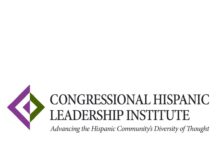WASHINGTON, June 11, 2019 /PRNewswire-HISPANIC PR WIRE/ — The national high school graduation rate reached an all-time high of 84.6 percent in 2017, up from 79 percent in 2010 and 71 percent since 2001. Hispanic, Black, and low-income students have continued to drive this increase with Hispanic students reaching an 80 percent graduation rate in 2017, Black students climbing to a 77.8 percent graduation rate, and low-income students reaching a 78.3 percent graduation rate. This progress over the last decade and a half means that more than 3.5 million additional students have graduated on-time instead of dropping out. Despite these gains, progress has slowed, signaling the need for a concerted and coordinated response at the national, state, community, and school levels to meet the needs of every young person and close remaining gaps.

“Thanks to sustained and focused efforts by districts, states, and the nation over the past decade and a half, millions of additional students have graduated high school rather than dropping out,” says John Bridgeland, CEO and Founder of Civic. “Yet, students continue to live in two educational nations — with most students in high schools with a graduation rate already at 90 percent, while other students remain trapped in low-performing high schools where the average graduation rate is only 40 percent.”
Connecting the Dots: High School and College Readiness
In recognition that high school graduation does not represent a finish line, this year’s Building a Grad Nation report, released today, includes a first-ever analysis of secondary school improvement to assess whether gains in high school graduation rates nationally and by state are accompanied by better preparation for postsecondary education.
The Secondary School Improvement Index uses the percent of students scoring proficient in reading and mathematics on the 8th grade NAEP exam, the percent of high school graduates who score a three or higher on Advanced Placement tests, and the percent of students who graduate on time within four years to determine the extent to which states have improved both graduation rates and academic outcomes. This analysis indicates there is no strong evidence at the national level that gains in high school graduation rates have come at the expense of college readiness. And, in most states, improvements in other measures of secondary school success have coincided with graduation rate increases—signaling that increases in high school graduation rates represent legitimate gains in preparedness. This is balanced by the fact that nearly one third of states did not experience these outcomes and can do better in making gains in both high school graduation rates and other indicators of academic achievement.
“Many states and districts have worked very hard over the past decades to raise graduation rates and academic achievement,” states Robert Balfanz, Director of the Everyone Graduates Center at Johns Hopkins University. “While considerable work remains to ensure all students are graduating high school prepared for post-secondary success, the secondary school index highlights that the majority of states’ efforts have paid off with more students graduating and being prepared for college level work.”
Closing Gaps To Reach 90 Percent Graduation Rate
Despite steady progress, the nation remains off-pace to reach the 90 percent graduation rate goal, which would require graduating an additional 199,466 more students on time and more than doubling the annual graduation rate of gain from since 2011 through 2020. To achieve an equitable path to 90 percent, the majority of these additional graduates would have to be students of color, low-income students, and students with disabilities.
The 2019 Building Grad Nation report provides the first-ever glimpse of homeless students’ graduation rates. Homeless students face multiple barriers to graduation above and beyond poverty alone, and preliminary data suggest that this population may have the lowest graduation rate of any subgroup in the country. The Education Leads Home campaign of Civic, Schoolhouse Connection, and America’s Promise, is engaging schools, states, and the nation in an effort to boost these graduation rates.
“To press forward, we need to focus on the places and populations where we still need to make progress. The preliminary data on homeless youth provide a window into the kind of challenges many young people face and the need for urgent action to address the needs and unlock the potential of every young person,” said John Gomperts, President and CEO at America’s Promise Alliance.
The Every School Succeeds Act requires all states to submit disaggregated graduation rates for homeless students for the first time in 2017-2018, holding states accountable for their progress. This year, however, the National Center for Homeless Education (NCHE) calculated a national graduation rate of 64 percent for homeless students based on data voluntarily shared with the Department of Education by 44 states. In addition, 26 states shared their graduation rates for homeless students with the Education Leads Home campaign, which are highlighted in this report.
“There are more than 1.3 million homeless PreK-12 students—an all-time high. We know that youth experiencing homelessness are 87 percent more likely to drop out of high school,” said Barbara Duffield, Executive Director of SchoolHouse Connection. “And without a high school degree, youth are at much greater risk of experiencing homelessness as young adults. But this tragic outcome can be prevented. States and schools can embrace the strong policies that are already on the books, and adopt best practices to support the social, emotional, and academic needs of homeless students.”
“Preparing students for a successful future certainly does not end with a high school diploma; however, it is a critical first step,” said Deb Delisle, CEO of the Alliance for Excellent Education. “We can celebrate the historic gains in high school graduation rates, but we must also recognize that a high school diploma remains out of reach for many of the nation’s students of color, students from low-income families, and other historically underserved students. We know that all students can succeed when given the necessary supports and opportunities. Our challenge is to energize a collective political will to do so.”
Authors and Sponsors
Building a Grad Nation is authored by Matthew Atwell, John Bridgeland, and Erin Ingram of Civic and Bob Balfanz of the Everyone Graduates Center at the Johns Hopkins University School of Education and released in partnership with America’s Promise Alliance and the Alliance for Excellent Education. Together, the four organizations lead the GradNation campaign, a nationwide effort to boost the on-time high school graduation rate to 90 percent and prepare young people for postsecondary enrollment and the workforce. This year’s report, presented by lead sponsor AT&T and supporting sponsors Pure Edge and the Raikes Foundation, is the tenth annual update on the progress and challenges in raising high school graduation rates. AT&T’s support of Building a Grad Nation is part of AT&T Aspire, the company’s signature philanthropic initiative focused on investing in education and job training to create a skilled and diverse workforce.
To read the full report and to access state and district data and other resources, visit: americaspromise.org/2019-building-grad-nation-report.
Civic is a public policy and strategy firm that helps corporations, nonprofits, foundations, universities, and governments develop and spearhead innovative public policies to strengthen our communities and country. Created to enlist the private, public and nonprofit sectors to help address our nation’s toughest problems, Civic fashions new initiatives and strategies that achieve measurable results in the fields of education, civic engagement, economic mobility, and many other domestic policy issues. www.civicllc.net
The Everyone Graduates Center at the Center for Social Organization of Schools at the Johns Hopkins University School of Education seeks to identify the barriers to high school graduation, develop strategic solutions to overcoming these barriers and build local capacity to implement and sustain the solutions so that all students graduate prepared for adult success. www.every1graduates.org
America’s Promise Alliance is the driving force behind a nationwide movement to improve the lives and futures of America’s youth. Its work is anchored in the belief that every young person deserves to succeed, and every adult is responsible for making that happen. By bringing together hundreds of national nonprofits, businesses, community and civic leaders, educators, citizens, and young people, the Alliance does what no single organization can do on its own: catalyze action on a scale that reaches millions of young people. www.AmericasPromise.org
The Alliance for Excellent Education is a Washington, DC-based national policy and advocacy organization dedicated to ensuring that all students, particularly those who are traditionally underserved, graduate from high school ready for success in college, work, and citizenship. www.all4ed.org
Media Contact:
Hanah Heintzelman
[email protected] | 732 737 1796
Logo – https://mma.prnewswire.com/media/397763/Americas_Promise_Alliance_seal_Logo.jpg
SOURCE America’s Promise Alliance






